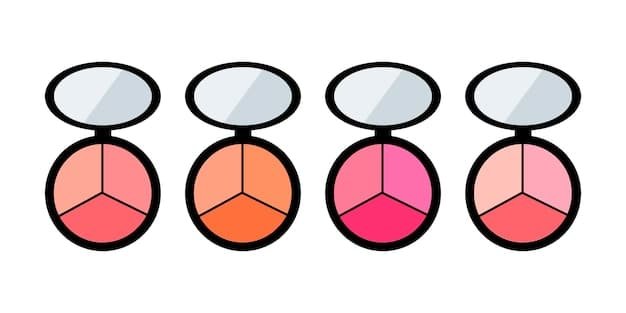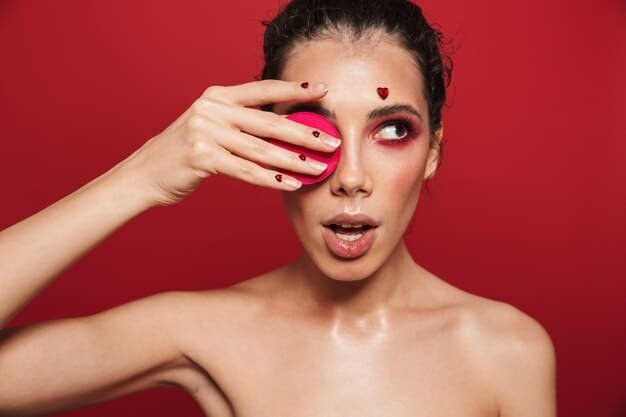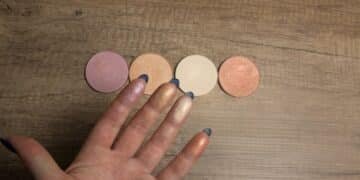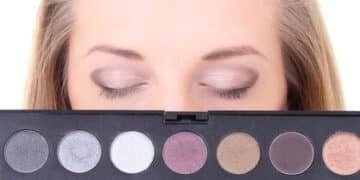Blush Application: Techniques, Shades & Placement (2025 Guide)

Blush application techniques for 2025 focus on enhancing individual face shapes with the right shade and strategic placement, creating a naturally radiant and sculpted look.
Ready to elevate your makeup game in 2025? Mastering blush application techniques involves understanding how to choose the right shade and placement to complement your unique face shape, bringing out your best features with a youthful glow.
Understanding Your Face Shape for Perfect Blush Placement
Identifying your face shape is the first step in determining the most flattering blush placement. Different face shapes benefit from different application techniques to enhance their natural features and create balance.
Identifying Common Face Shapes
Before diving into blush application, let’s explore some common face shapes and their characteristics.
- Round: Characterized by full cheeks and a similar width and length.
- Oval: Longer than wide, with a slightly rounded jawline and forehead.
- Square: Defined by a strong jawline and a similar width across the forehead and jaw.
- Heart: Wider forehead and cheekbones that narrow down to a pointed chin.
- Oblong: Similar to oval but longer, with elongated features.
- Diamond: Wide cheekbones with a narrower forehead and jawline.
Understanding these shapes allows for a tailored approach to blush application, ensuring the most flattering and natural-looking results.

Once you’ve identified your face shape, you can begin to experiment with different blush placements to see what works best for you. The goal is to create balance and enhance your natural features.
Choosing the Right Blush Shade for Your Skin Tone
Selecting the perfect blush shade can significantly enhance your complexion. The key is to consider your skin tone and undertones to achieve a natural and harmonious look.
Understanding Skin Tones and Undertones
Skin tone refers to the surface color of your skin, while undertone is the subtle, underlying hue that affects how colors appear on your skin.
- Fair Skin: Light and porcelain skin that can easily burn in the sun.
- Light Skin: Skin that is slightly darker than fair, with more tolerance to the sun.
- Medium Skin: Skin with a neutral balance, often tanning easily.
- Tan Skin: Skin that is naturally darker and tans easily.
- Dark Skin: Rich and deep skin tones that rarely burn.
Undertones fall into three main categories: warm, cool, and neutral. Determining your undertone helps you choose blush shades that complement your complexion.
Blush Shades for Different Skin Tones
Here’s a guide to help you select the most flattering blush shades for your skin tone:
- Fair Skin: Soft pinks, peaches, and light corals enhance fair skin without overpowering it.
- Light Skin: Rosy pinks, apricot, and mauve shades add a healthy flush to light skin.
- Medium Skin: Berry tones, warm pinks, and peachy corals create a natural-looking glow on medium skin.
- Tan Skin: Vibrant corals, deep peaches, and rose shades complement tan skin beautifully.
- Dark Skin: Rich berry tones, vibrant oranges, and deep reds create a stunning effect on dark skin.
Experimenting with different shades is essential to finding the perfect blush for your unique skin tone and undertone. Don’t be afraid to try new colors and see what works best for you.
Blush Application Techniques for Round Faces
For round faces, the goal is to create definition and add dimension to the cheeks. Strategic blush placement can help sculpt the face and create a more angular appearance.
Techniques for Round Faces
Applying blush along the cheekbones at an angle helps create a more defined and sculpted appearance.
- Contouring with Blush: Apply blush just below the cheekbones, blending upwards towards the temples.
- Avoid Apple of the Cheeks: Applying blush directly to the apple of the cheeks can make the face appear rounder.
- Elongate the Face: Applying blush in a diagonal line can help elongate the face and create a more angular appearance.
Using a matte blush can also help create a more sculpted effect for round faces. Avoid shimmery or overly bright blushes, as they can accentuate the roundness of the face.
Blush Application Techniques for Oval Faces
Oval faces are considered the most versatile shape, allowing for a variety of blush application techniques. The goal is to enhance the natural balance and symmetry of the face.
Techniques for Oval Faces
For oval faces, focus on enhancing the natural cheekbones and adding a healthy flush to the complexion.
- Apple of the Cheeks: Applying blush to the apple of the cheeks creates a youthful and radiant appearance.
- Blend Outwards: Blend the blush outwards towards the temples for a seamless and natural finish.
- Horizontal Application: Applying blush in a horizontal line along the cheekbones can enhance the natural contours of the face.
Experiment with different blush shades and placements to find what best complements your features. Oval faces can pull off a wide range of blush looks, from subtle and natural to bold and dramatic.
Blush Application Techniques for Square Faces
For square faces, the goal is to soften the angles and add a touch of roundness to the cheeks. Strategic blush placement can help balance the strong jawline and create a more harmonious appearance.
Techniques for Square Faces
Applying blush to the apple of the cheeks and blending in a circular motion helps soften the angles of square faces.
- Circular Motion: Apply blush to the apple of the cheeks in a circular motion, blending outwards towards the temples.
- Soften the Jawline: Using a soft, diffused blush can help soften the strong jawline of square faces.
- Avoid Sharp Lines: Avoid applying blush in sharp, angular lines, as this can accentuate the squareness of the face.
Using a slightly shimmery blush can also add a touch of radiance to square faces, softening the overall appearance. Choose shades that complement your skin tone and undertone for the most flattering results.

Blush Application Techniques for Heart-Shaped Faces
For heart-shaped faces, the goal is to balance the wider forehead and narrower chin. Strategic blush placement can help create a more proportional and harmonious appearance.
Techniques for Heart-Shaped Faces
Applying blush in a “C” shape from the temples to the cheekbones helps balance the wider forehead and draw attention to the cheekbones.
- “C” Shape Application: Apply blush in a “C” shape from the temples to the cheekbones, blending downwards towards the apple of the cheeks.
- Soften the Chin: Avoid applying too much blush to the apple of the cheeks, as this can accentuate the narrowness of the chin.
- Horizontal Blend: Blending the blush horizontally can help create a wider appearance to the lower part of the face.
Using a soft, natural-looking blush shade can also help balance the features of heart-shaped faces. Choose shades that complement your skin tone and undertone for the most flattering results.
Tools and Products for Perfect Blush Application
Having the right tools and products can make a significant difference in your blush application technique. Investing in high-quality brushes and blushes can help you achieve a flawless and natural-looking finish.
Essential Blush Tools
Here are some essential tools for perfect blush application:
- Blush Brush: A soft, fluffy blush brush is ideal for applying and blending blush seamlessly.
- Angled Brush: An angled brush is perfect for contouring and defining the cheekbones.
- Stippling Brush: A stippling brush can be used to create a diffused and natural-looking blush application.
Choosing the right brush for your specific application technique can help you achieve the desired results. Experiment with different brushes to find what works best for you.
Types of Blush Products
Blush products come in various forms, including powder, cream, and liquid. Each type offers different benefits and is suitable for different skin types and preferences.
- Powder Blush: Ideal for oily skin, powder blush offers a matte finish and is easy to blend.
- Cream Blush: Perfect for dry skin, cream blush provides a dewy and hydrating finish.
- Liquid Blush: Suitable for all skin types, liquid blush offers a buildable and long-lasting flush of color.
Choosing the right type of blush for your skin type and desired finish can help you achieve a flawless and long-lasting blush application.
| Key Point | Brief Description |
|---|---|
| 😊 Face Shape | Identify your face shape to guide blush placement. |
| 🎨 Skin Tone | Choose blush shades that complement your skin tone. |
| 🖌️ Application | Apply blush based on your face shape and desired look. |
| ✨ Tools | Use quality blush brushes for seamless application. |
Frequently Asked Questions
To determine your face shape, look in the mirror and trace the outline of your face. Compare the shape to common face shapes like round, oval, square, heart, diamond, and oblong to find the closest match.
For fair skin, soft pinks, peaches, and light corals are ideal as they add a subtle flush of color without being too overpowering. These shades enhance the natural complexion of fair skin.
To apply blush for a round face, focus on creating definition by applying blush along the cheekbones at an angle, blending upwards towards the temples. Avoid applying blush directly to the apple of the cheeks.
While cream blush is generally better for dry skin, it can be used on oily skin if set with a translucent powder. Powder blush is typically recommended for oily skin due to its matte finish.
The best blush brush to use is a soft, fluffy brush that allows for seamless application and blending. Angled brushes are also great for contouring, and stippling brushes can create a more diffused look.
Conclusion
Mastering blush application techniques for 2025 involves understanding your face shape, choosing the right shade for your skin tone, and using the appropriate tools. By following these tips, you can achieve a flawless and natural-looking blush application that enhances your unique features, leaving you with a radiant and youthful glow.





